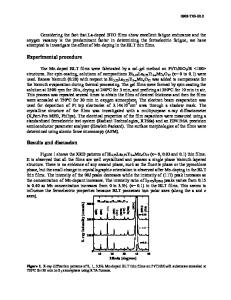Crystallization of Sub-100 nm-Thick Bi 4-x La x Ti 3 O 12 Films on Silicon Substrates and Their Electrical Properties
- PDF / 1,158,718 Bytes
- 6 Pages / 612 x 792 pts (letter) Page_size
- 74 Downloads / 289 Views
C11.2.1
Crystallization of Sub-100 nm-Thick Bi4-xLaxTi3O12 Films on Silicon Substrates and Their Electrical Properties Atsushi Kohno*, **, Fumitake Ishitsu*, Kazuhiro Matuo* and Hiroyuki Tomari* * Department of Applied Physics, Fukuoka University, 8-19-1 Nanakuma, Jounan-ku, Fukuoka 814-0180, Japan. ** Advanced Materials Institute, Fukuoka University, Fukuoka 814-0180, Japan. ABSTRACT Polycrystalline Bi4-xLaxTi3O12 (BLT) thin films were formed on p-Si(100) substrates. Crystallization of the film was investigated quantitatively by X-ray diffraction (XRD) and X-ray reflection (XRR) analyses. The film was crystallized onto bismuth-oxide layered perovskite structure when annealing temperatures became higher than 550°C. The annealing time dependence of diffraction intensity and peak width indicated that grain growth occurred during crystallization. Moreover, it was shown that the average crystal dimension in the BLT film reached ca. 60 nm by 120-min annealing. That value is comparable to the BLT thickness. Film thickness and density were evaluated by XRR analysis. Simulation fitting showed that the BLT film was densified and that an interfacial layer was formed during crystallization. Pole figure measurements also suggested that the c-axis of BLT was preferentially oriented to nearly parallel the surface. Clockwise hysteresis loops were observed at room temperature in capacitance-voltage (C-V) characteristics of Au/BLT/p-Si structures. The coercive field and the dielectric constant of 65 nm-thick BLT films crystallized at 550°C for 60 min were evaluated to be ca. 23 kV/cm and ca. 17, respectively. INTRODUCTION Ferroelectric thin films have attracted much attention for non-volatile memory applications from the viewpoint of high-speed signal processing. Thin films of bismuth layer-structured ferroelectrics, such as SrBi2Ta2O9 (SBT), Bi4Ti3O12 (BIT) and La-substituted BIT (Bi4-xLaxTi3O12 : BLT), are recognized as good candidate materials for memory applications because of their fatigue-free and lead-free natures [1–3]. Reportedly, BLT can be formed at lower temperature than SBT [3]; moreover, the effect of substitution of La and V in BIT thin films and the electronic structure of BLT have been studied [4, 5]. Chemical solution decomposition is available as a low-cost process for deposition of BLT polycrystalline thin film that has good ferroelectric properties [6, 7]. In aspects of non-destructive read-out and device scaling capabilities, metal-ferroelectric semiconductor (MFS) structured memory offers advantages over storage capacitor-type ferroelectric random access memory (FeRAM). Crystallization, electric properties of the thin films, and the ferroelectric/silicon interface property seriously affect FET characteristics. These properties are crucial for development of MFS field-effect transistor (FET)-type memory. Electrical characteristics of the BIT and BLT thin films on silicon substrates or on insulator/silicon substrates have been reported [8–14]. However, for low-voltage memory, crystallization and electrical prop
Data Loading...










